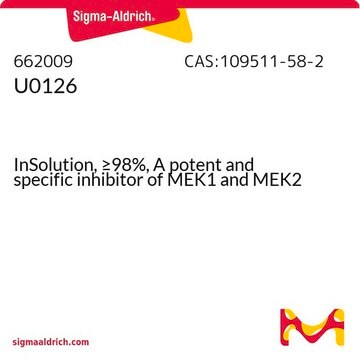444966
MEK1/2 Inhibitor III
The MEK1/2 Inhibitor III, also referenced under CAS 391210-10-9, controls the biological activity of MEK1/2. This small molecule/inhibitor is primarily used for Phosphorylation & Dephosphorylation applications.
Sinónimos:
MEK1/2 Inhibitor III, PD325901, PD0325901, N-((2R)-2,3-Dihyroxypropoxy)-3,4-difluoro-2-((2-fluoro-4-iodophenyl)amino)-benzamide, PD 0325901, MEK Inhibitor III
About This Item
Productos recomendados
Nivel de calidad
Análisis
≥95% (HPLC)
formulario
solid
fabricante / nombre comercial
Calbiochem®
condiciones de almacenamiento
OK to freeze
protect from light
color
white to off-white
solubilidad
DMSO: 20 mg/mL
Condiciones de envío
ambient
temp. de almacenamiento
2-8°C
InChI
1S/C16H14F3IN2O4/c17-11-3-2-10(16(25)22-26-7-9(24)6-23)15(14(11)19)21-13-4-1-8(20)5-12(13)18/h1-5,9,21,23-24H,6-7H2,(H,22,25)/t9-/m1/s1
Clave InChI
SUDAHWBOROXANE-SECBINFHSA-N
Descripción general
Envase
Advertencia
Reconstitución
Otras notas
Leyton, J., et al. 2008. Mol. Cancer Ther.7, 3112.
Silva, J., et al. 2008. PLoS Biol.6, 2237.
Ying, Q.L., et al. 2008. Nature453, 519.
Bain, J., et al. 2007. Biochem. J.408, 297.
Solit, D.B., et al. 2006. Nature439, 358.
Información legal
Palabra de señalización
Danger
Frases de peligro
Consejos de prudencia
Clasificaciones de peligro
Acute Tox. 3 Oral - Aquatic Chronic 4 - STOT RE 2
Código de clase de almacenamiento
6.1C - Combustible acute toxic Cat.3 / toxic compounds or compounds which causing chronic effects
Clase de riesgo para el agua (WGK)
WGK 3
Punto de inflamabilidad (°F)
Not applicable
Punto de inflamabilidad (°C)
Not applicable
Certificados de análisis (COA)
Busque Certificados de análisis (COA) introduciendo el número de lote del producto. Los números de lote se encuentran en la etiqueta del producto después de las palabras «Lot» o «Batch»
¿Ya tiene este producto?
Encuentre la documentación para los productos que ha comprado recientemente en la Biblioteca de documentos.
Nuestro equipo de científicos tiene experiencia en todas las áreas de investigación: Ciencias de la vida, Ciencia de los materiales, Síntesis química, Cromatografía, Analítica y muchas otras.
Póngase en contacto con el Servicio técnico









